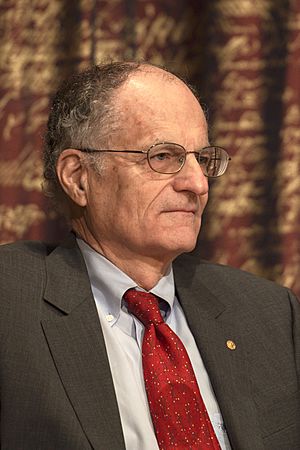Thomas J. Sargent facts for kids
Thomas John Sargent (born July 19, 1943) is a famous American economist. He is a professor at New York University. He studies how big economies work, how money affects them, and how to use data to understand economic changes. As of 2025, he is one of the most cited economists in the world.
In 2011, he won the Nobel Memorial Prize in Economics. He shared this award with Christopher A. Sims. They won for their research on how different events cause effects in the economy.
Quick facts for kids
Thomas J. Sargent
|
|
|---|---|

Sargent in 2011
|
|
| Born | July 19, 1943 Pasadena, California, U.S.
|
| Institution | Hoover Institution Carnegie-Mellon University University of Pennsylvania University of Minnesota University of Chicago Stanford University New York University Seoul National University Peking University HSBC Business School |
| Field | Macroeconomics, monetary economics |
| Doctoral advisor |
John R. Meyer |
| Doctoral students |
Robert Litterman Monika Piazzesi Mariacristina De Nardi Ellen McGrattan Lars Peter Hansen Albert Marcet Noah Williams Laura Veldkamp Richard Clarida Danny Quah Sagiri Kitao Martin Eichenbaum Lawrence J. Christiano Greg Kaplan |
| Influences | John F. Muth Robert E. Lucas, Jr. Christopher A. Sims Neil Wallace |
| Awards | Nemmers Prize in Economics (1996) NAS Award for Scientific Reviewing (2011) Nobel Memorial Prize in Economic Sciences (2011) |
| Information at IDEAS / RePEc | |
| Military career | |
| Allegiance | |
| Service/ |
|
| Years of service | 1968-1969 |
| Rank | |
Contents
Early Life and Education
Thomas Sargent went to Monrovia High School. He then studied at the University of California, Berkeley. He earned his bachelor's degree in 1964. He was recognized as the most distinguished scholar in his class.
He continued his studies at Harvard. He received his PhD in 1968. His teacher there was John R. Meyer. After college, he served in the U.S. Army as a captain.
Teaching Career
After his time in the army, Sargent began teaching. He taught at many well-known universities. These include the University of Pennsylvania, University of Minnesota, and University of Chicago. He also taught at Stanford University and Princeton University. Since 2002, he has been a professor at New York University.
He was also the president of important economic groups. These include the American Economic Association. In 1983, he became a member of the National Academy of Sciences. He has been a senior fellow at the Hoover Institution since 1987.
Big Ideas in Economics
Thomas Sargent is known for leading the "rational expectations revolution." This idea suggests that people can predict the future of the economy. They can do this almost as well as economists can with their models. This idea was first introduced by John Muth. Then, Robert Lucas, Jr. and Edward C. Prescott developed it further.
Sargent worked closely with Lucas and Neil Wallace. Together, they helped create a new way of thinking about how economies work.
Key Contributions
Sargent's main contributions to rational expectations include:
- Showing how rational expectations affect money policies.
- Making it easier to use rational expectations in statistics.
- Giving early examples of how rational expectations explain things like inflation.
- Studying how money and government spending must work together over time.
- Looking at history to explain big changes in economic policies.
In 1975, he and Wallace proposed an idea called the "policy-ineffectiveness proposition." This idea challenged some basic beliefs of older economic theories.
Newer Research
Sargent continued to improve his ideas about rational expectations. He studied how people learn and adapt in economic systems. He also looked at situations where people don't fully trust their economic models. He worked with Lars Peter Hansen on these ideas.
Sargent also helped introduce "recursive economics" to academic study. This is a way to study economic problems that repeat over time. He wrote textbooks with Lars Ljungqvist that are important for economics students.
Understanding Unemployment
Sargent and Ljungqvist also studied why unemployment rates differ. They looked at Europe and the United States over the last 30 years. They wanted to know why Europe had lower unemployment in the 1950s and 60s. They also researched why Europe had higher unemployment after 1980.
Their research suggests that Europe has stronger job protection laws. It also has more generous unemployment benefits. Even though these rules stayed the same, the world changed. Workers faced a higher risk of their skills becoming less useful in the 1980s.
Winning the Nobel Prize
On October 10, 2011, Thomas Sargent received the Nobel Memorial Prize in Economic Sciences. He shared the prize with Christopher A. Sims. They were honored for their research on cause and effect in the economy.
Sargent gave his Nobel lecture on December 11, 2011. It was titled "United States Then, Europe Now."
Teaching and Mentoring
Sargent is known as a dedicated teacher. Many of his former students are now leaders in economic research. His reading group at Stanford and NYU is very popular among graduate students.
In 2016, Sargent helped start the QuantEcon project. This project creates free computer tools for economics. He is currently the director of the Sargent Institute of Quantitative Economics and Finance in China.
Images for kids
See also
 In Spanish: Thomas J. Sargent para niños
In Spanish: Thomas J. Sargent para niños


